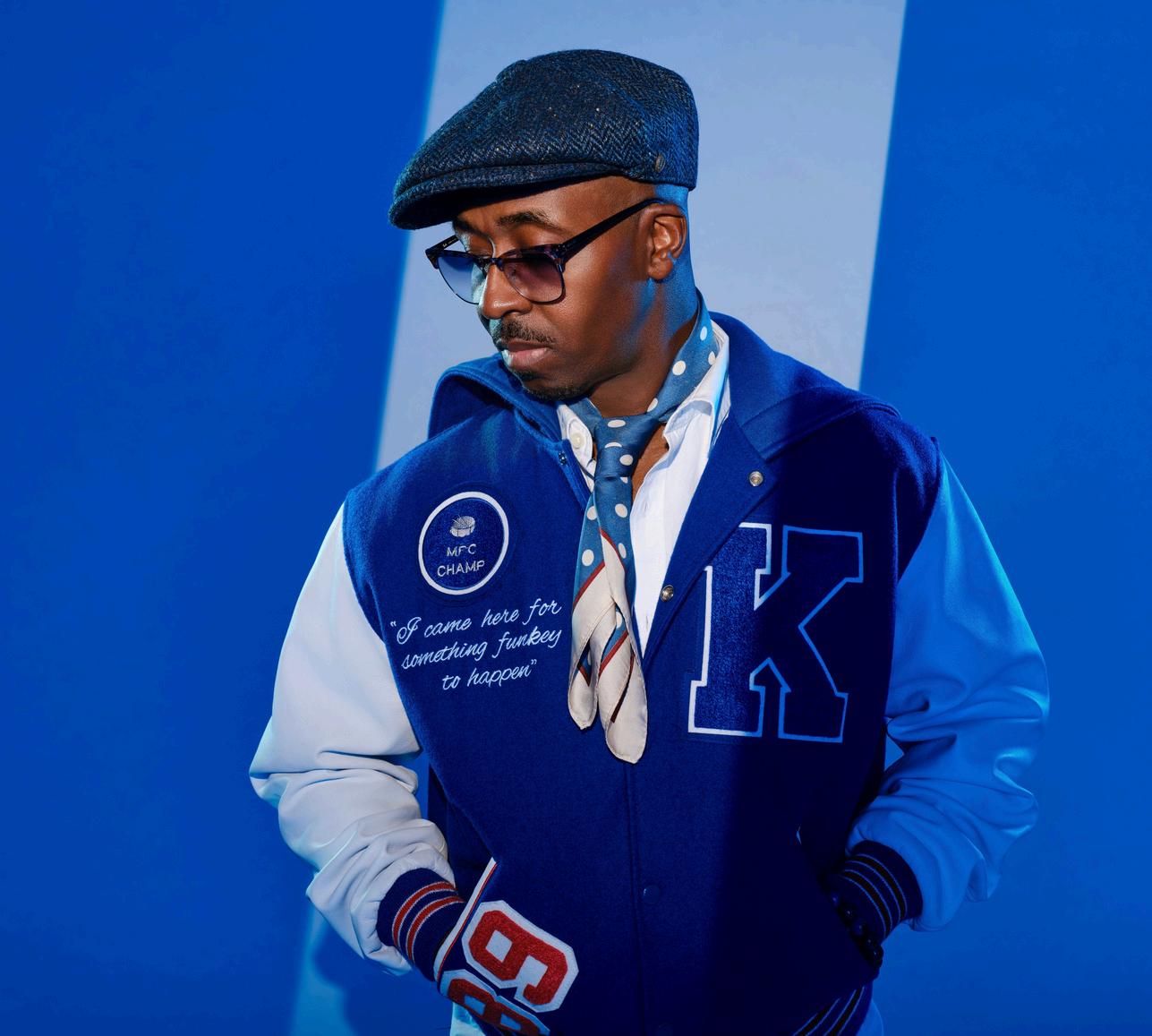KWAME
THREE DECADES OF REINVENTION—AND A NEW CHAPTER WITH THE DIFFERENT KIDS





THREE DECADES OF REINVENTION—AND A NEW CHAPTER WITH THE DIFFERENT KIDS





Thestoryofhip-hopisoneofconstantevolution—borninthelate1970s,cementedinthe 1980s,andtransformedthrougheverydecadesince Fromtherawbeatsandlyricalingenuity thatemergedinNewYork’sboroughstotheglobalculturalmovementitistoday,hip-hophas alwaysbeendefinedbyinnovation,resilience,andreinvention. FewartistsembodythatspiritofreinventionmorethanKwamé.Risinginthelateeightieswith aplayful,yetlyricallysharpstyle,Kwamécarvedouthisplaceduringaperiodwhenhip-hop wasestablishingitsvoiceinmainstreamculture Hismusicwasclever,stylish,and unapologeticallydifferent helpingtoprovethathip-hopcouldbeversatile,dynamic,and fashionableallatonce.Beyondhissound,hiscolorfulpolka-dotaestheticandboldfashion choicesleftamarkthatstretchedbeyondmusic,influencinghowhip-hopwasseenand celebrated.
WhatmakesKwamé’sjourneyremarkableisnotjusthisearlysuccess,buthisabilitytoreemergeandremainrelevantdecadeslater.Hecontinuestoshapetheculturethroughmusic bothasaperformerandaproducer whilealsoleavinghisimprintinfashion,branding,and culturalcommentary.Hisresurgenceremindsusthattrueartistrydoesn’tfade;itevolveswith time,inspiringnewgenerationswhilereaffirmingthefoundationlaidyearsago.
Aship-hopcelebratesitsmilestones,figureslikeKwaméprovethatthegenre’sstoryisstill beingwritten layeredwithhistory,creativity,andtheendlesspursuitofauthenticity.His contributionsreminduswhyhip-hopremainsnotonlyaformofmusic,butalsoacultural forcethatdefineshowweseeourselves,andhowtheworldseesus.

Longbeforehip-hopdiscoveredthepowerof “branding, ” KwaméHollandarrivedwithavision
TheQueens-bornteenemceewhohitin 1989 withaliveband, brainypunchlines, anda signaturepolka-dotaestheticgrewintooneofthequietarchitectsof 2000srapandR&B then circledbacktothemicwithafullyformed, grown-manvoice
His 2025 album, The Different Kids, isn’t just a comeback; it’s a summation of everything he’s learned as a writer, producer, executive, and cultural tinkerer who’s stayed indispensable for over three decades.
At sixteen, Kwamé debuted with Kwamé the Boy Genius: Featuring a New Beginning, a rare rap album built around a backing band and a playful, literate persona. In an era defined by leather suits and hard poses, he doubled down on color and charisma: the polka-dot motif that ran through his visuals became both a calling card and a fad—proof that style could be as declarative as a hook. The followup, A Day in the Life: A Pokadelick Adventure (1990), pushed further with a high-concept, slice-ofschool-life narrative that previewed the cinematic ambitions he’d later bring to television and film work.
Across those early releases—and the grittier turns of Nastee (1992) and Incognito (1994)—Kwamé mapped out a creative range that would become his career’s throughline: clever without being coy, adventurous without losing the groove, serious about craft even when the subject matter was light on its feet. None of that would be left behind when he stepped out of the spotlight and into the studio booth as a producer.
If the first act made Kwamé a cult favorite, the second made him a force. Reemerging in the 2000s under his own name and the alias K-1 Mil, he helped power a run of mainstream hits that defined the sound of mid-decade radio. He co-produced Lloyd Banks’ 2004 smash “On Fire” alongside Eminem, a record that cracked the Hot 100’s top ten and was certified Gold. The following year he produced and co-wrote Will Smith’s global hit “Switch,” a kinetic, party-ready single that topped digital charts and went top-10 on the Hot 100. These weren’t merely credits; they were proof that the Boy Genius ear had matured into a hitmaker’s touch.
The résumé sprawled: placements with LL Cool J and Mary J. Blige, scoring and music for film/TV (Drumline, Step Up, Freedom Writers, Coach Carter), and later, label-building and artist development. In 2015 he founded Make Noise Recordings and produced Vivian Green’s Vivid, yielding the radiodominant “Get Right Back to My Baby.” If early-career Kwamé championed individuality onstage, midcareer Kwamé engineered longevity from behind the glass—helping other artists crystalize identity and find audience.
What makes The Different Kids so resonant isn’t just that Kwamé still raps with the spark of his polkadot days—it’s how he threads that history into a forward-looking framework. He taps into nostalgia, not as a gimmick, but as a grounding force. Longtime fans hear echoes of his Boy Genius cadences, the playful swing of his early storytelling, and the vibrant energy that made him stand out in the late ’80s and early ’90s. Those nods to the past function like cultural anchors, reminding listeners of hip-hop’s colorful beginnings before the genre grew hardened by industry demands.
Yet at the same time, Kwamé refuses to be locked in amber. The Different Kids builds on that legacy with crisp, modern production and a renewed clarity in his message. The album’s arrangements are tight and radio-ready, but they avoid formula. His lyrics carry the buoyancy of his teenage debut, now laced with the wisdom of a man who’s seen how the industry can elevate and consume talent. This duality—playful nostalgia and future-driven storytelling—makes his music both comforting and catalytic.
By doing so, Kwamé is shaping the culture in a much-needed new direction. At a time when hip-hop often splits into either overly nostalgic throwbacks or algorithm-tailored trends, he offers a third way: music that respects the past without replicating it, and that engages the present without pandering to it. He models longevity as a creative stance, showing younger artists that reinvention doesn’t mean abandoning your roots —it means reactivating them in service of growth.
The new album: The Different Kids
Released August 29, 2025, The Different Kids is a title that nods to the multi-hyphenate kids Kwamé raised and the creative “kids” he’s mentored and collaborated with, as well as the inner kid who never stopped experimenting. Across the set, he weaves braggadocio with diaristic detail, toggling between the nimble cadences that made his teenage records pop and the seasoned authority of a producer-executive who’s seen the business from every angle. Early singles “Ms Mary Mack” and “Hello / Anybody?” set the tone: classic drum programming and buoyant basslines, elastic rhyme schemes, and grown-man wit that keeps the verses light on their feet and heavy on craft.
The reception underscored the narrative: after more than three decades, here was an emcee sounding energized, contemporary, and—importantly—still distinct. Reviews highlighted both the album’s concise, concept-touched construction and the effortless way he slips between eras without nostalgia cosplay. It feels like the record only Kwamé could make: a producer’s precision stitched to an emcee’s curiosity.
1) Aesthetics as authorship.
Kwamé’s early polka-dot era wasn’t just a look; it was an argument that hip-hop could be expansive, theatrical, and visually literate. In an industry where presentation often precedes discovery, he modeled how distinctive style could function as narrative shorthand—a lesson absorbed by generations of artists who turn wardrobes into world-building.
2) The producer-writer blueprint. Plenty of rappers become producers or vice versa, but Kwamé’s transition set a standard for breadth. The “On Fire”/“Switch” run proved he could translate emcee instincts into global pop mechanics without sacrificing swing or personality. You can hear his fingerprints in the clean, hook-engineered architecture of mid-2000s radio rap and in the career arcs of artist-producers who treat the board as a second mic.
3) Cross-medium musicianship. From film cues to TV scoring, he brought hip-hop’s rhythmic logic to screen storytelling, nudging the culture further into the audiovisual mainstream and modeling a portfolio career long before that was the norm.
4) Executive stewardship and mentorship. Make Noise wasn’t just vanity-label optics; it was infrastructure. The company’s work with Vivian Green —especially “Get Right Back to My Baby”—demonstrated how seasoned songcraft and smart A&R can refresh an artist and recalibrate radio. In an industry that constantly churns, Kwamé’s executive phase showed how to build durable lanes for mature Black music.
Hip-hop is in a reflective moment, balancing 50-year heritage with the algorithm’s appetite for the new. The Different Kids threads that needle. Sonically, it’s fleet—records rarely overstay their welcome—and it favors tight arrangements, punchy drums, and melodies that sneak back hours later. Lyrically, it is playful but precise, more conversational than confessional, with the rhinestone of wordplay set in the gold of grown perspective.
But the bigger story is continuity. Kwamé’s career maps a route many younger artists now chase: use an unforgettable persona to enter; learn to write and produce to survive; then leverage that knowledge to lift others—and, when the time is right, step back to the front with something only you can deliver. That looping life cycle is baked into The Different Kids: the artist who once taught kids to love being “different” returns to show what it looks like when those kids grow up and keep creating.
The legacy, in four beats
Innovation as normal practice. From the live-band debut to the concept-album sophomore effort, Kwamé helped broaden what hip-hop albums could be.
Hits with staying power. “On Fire” and “Switch” aren’t just Wikipedia lines—they’re cultural timestamps for a generation that danced, drove, and dated to them. Infrastructure builder. With Make Noise and his television/film work, he turned personal taste into institutional presence.
Artist’s artist. The Different Kids reminds peers and protégés that technique ages well when you keep interrogating it. It’s a veteran record that feels light on its feet and heavy with know-how.
Kwamé’s arc reads like a creative manifesto: Be unmistakable. Learn every job. Share the wins. Then come home to the mic and show your work. The Different Kids is that homecoming—fresh enough for today’s playlists, rooted enough to feel inevitable. For an artist who helped make “different” cool in the first place, it’s only right that the newest chapter proves how powerful that difference still is.